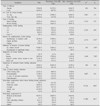Abstract
Purpose
This study was done to identify that Rooming-in of new mothers have an influence on continuous breast feeding.
Method
This is a comparative survey study which was done by self reported questionnaire and telephone contacts. The subjects are collected from two groups which consist of 29 in Rooming-in group and 24 in Non-Rooming-in group respectively. The data were collected method of this study was lists of given to mothers while they were in the hospital and interviews by telephone were done at their home 3 months and 6 months after delivery.
Result
The results of this study were as follows: 1. The rates of breast feeding were 79.3% in the Rooming-in group and 41.7% in the non-Rooming-in group after 3 months. There was a statistically significant difference between the two groups(χ2=10.217, p=.009). 2. The rates of breast feeding were 69.0% in the Rooming-in group and 29.2% in the Non-Rooming-in group at 6 months. There was a statistically significant difference between the two groups(χ2=10.310, p=.012).
Conclusion
Rooming-in system provoke an increase of the breast feeding rate in new mothers and encourage them to keep breast feeding. In addition, it would be desirable that hospitals apply Rooming-in system actively and encourage new mothers to breast feed for 24 hours a day. It could be make breast feeding successful.
Figures and Tables
References
1. Chang I.S. Development of network model for new mother's role. 2001. Seoul: Chungang University;Unpublished doctoral dissertation.
2. Greenberg M., Lind I.R. First mothers rooming-in with their newborns: Its impact upon the mother. Amer J orthopsychiat. 1973. 43(5):783–788.
3. Hwang M.S. Effect of rooming-in on maternal role and breast-feeding. 1996. Seoul: Seoul National University;Unpublished master's thesis.
4. Hwang W.J. The study on decision factor of breast-feeding- the focus on data of a whole country delivery capacity and research on the actual condition of family health in 2000-. 2003. Seoul: Yonsei University;Unpublished master's thesis.
5. Im B.D., Park J.H. Management state of baby friendly hospital initiative and change in breast feeding rate. 2002. 12th. Korean Society of Maternal and Child Health;49–50.
6. Kang K.H. Study research about actual condition of breast feeding after rooming-in of general hospital. J Pusan Nurses Association. 2001. 31:24–41.
7. Kim S.K., Joe A.J., Kim Y.K., Park S.K., Lee K.W. A whole country delivery capacity and research on the actual condition of family health in 2003. 2004. Korea Institute for Health and Social Affairs.
8. Kim E.S. The effect of rooming in on maternal attitude and self confidence for infant care. 2000. Seoul: Seoul National University;Unpublished master's thesis.
9. Kim Y.M. Effect of breast feeding empowerment program to complete breast feeding. 2006. Seoul: Seoul National University;Unpublished doctoral dissertation.
10. Kwak Y.H., Han O.S., Kim H.S. Survey of breast feeding rate of roomnig in system. Clinical Nursing Researh. 1998. 4(2):71–89.
11. Lawrence P.B. BREAST MILK: Best source of nutrition for term and preterm infants. Pediatric Clinics of North Am. 1995. 41:925–941.
12. Lee S.O. A study about breast-feeding knowledge, attitude and problem of breast-feeding in early postpartum period and breast-feeding practice. Korean Journal of Women Health Nursing. 2003. 9(2):179–188.
13. Ministry of Government Legislation. 2008. http://www.law.go.kr/LSW/LsAstSc.do?menuId=9&cptOfiCd=00163#.
14. Nyqvist K.H. Breastfeeding support in neonatal care: An example of the integration of international evidence and experience. Newborn and Infant Nurs Reviews. 2005. 5(1):34–35.
15. Osorio A., Rossello J.L., Capurro H. A rooming-in program for mothers and newborns. Bullpan Am Health Organization. 1975. 9(2):129–134.
16. Reeder S.J., Martin L.L. Maternity Nursing: Family, newborn and womens health care. 1987. 16th. JB Lippincott.
17. Riordan J. A practical guide to breast feeding. 1983. Mosby.
18. Song J.E. A comparative study on the level of postpartum womens fatigue between rooming-in and non rooming-in groups. 2001. Seoul: Yonsei University;Unpublished master's thesis.
19. Shin G.Y., Kim O.J., Park J.H., Lee J.L. Effects of rooming-in on continuation of breast-feeding and maternal identity. Korean Journal of Women Health Nursing. 2002. 8(3):402–411.
20. Suddenly increasing breast feeding rate, Lowering Breast Feeding Room. The National Assembly of The Republic of Korea. 2008. 10. 07. Reporting Data from http://www.assembly.go.kr/.
21. UNICEF. The state of the world's children. 2004. Oxford University Press.
22. Waldenstrom U., Swenson A. Rooming-in at night in the postpartum ward. Midwifery. 1991. 7:82–89.
23. The optimal duration of exclusive breastfeeding. WHO. 2002. www.who.int/child-adolescent-health.
24. Wojnar D. Maternal perceptions of early breast feeding experiences and breast feeding outcomes at 6weeks. Clinical Effectiveness in Nurs. 2004. 8:93–100.




 PDF
PDF ePub
ePub Citation
Citation Print
Print






 XML Download
XML Download